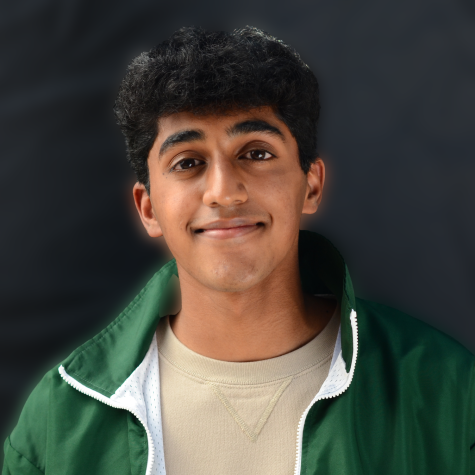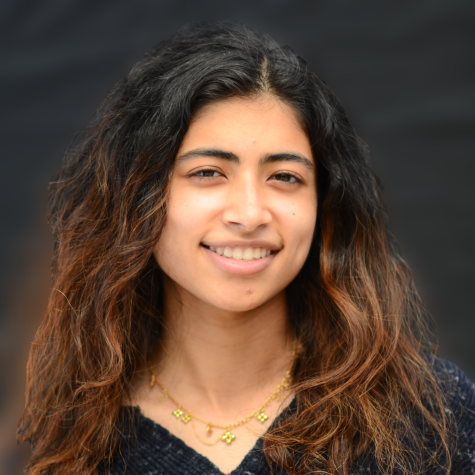Humans of Harker: Selflessness and sincerity
Sasvath Ramachandran tackles complex problems as an athlete and an academic
“I enjoy the experimental part most, where you build an experiment to test the physics concepts and see the discrepancies between how [the system] should behave theoretically and how it actually behaves. That’s really useful for me, because if you keep studying formulas from a textbook, eventually it becomes monotonous, and you lose track of purpose,” Sasvath Ramachandran (12) said.
To most people, gyro rings — devices composed of a larger metal ring with several smaller washers threaded on to it — are merely toys, a medium to execute various tricks on, much like the modern day fidget spinner. Give the washers a gentle swipe with your fingers, and rotate the outer ring in different ways — up and down, side to side — to notice that, in each scenario, the washers will continue spinning, in an axis perpendicular to the motion of the outer ring.
But why do gyro rings behave in this manner? This question is one that Sasvath Ramachandran (12) delved into last year as a member of Harker’s United States Association for Youth Physicists Tournament (USAYPT) chapter. Working alongside juniors Alex Lan, Stephen Xia and Jacob Huang and under the guidance of physics teacher Dr. Mark Brada, Sasvath took great pleasure in unraveling the physical complexity hidden behind the mirage of this seemingly simple toy.
“With USAYPT, you take something so simple and mundane, like a gyro ring, and you look into it, and it’s mind-blowing how complex it becomes,” Sasvath said.
Sasvath particularly enjoys the experimental components of USAYPT, which he feels offers a refreshing change of pace from the rote memorization and application of physics formulas.
“I enjoy the experimental part most, where you build an experiment to test the physics concepts and see the discrepancies between how [the system] should behave theoretically and how it actually behaves,” Sasvath said. “That’s really useful for me, because if you keep studying formulas from a textbook, eventually it becomes monotonous, and you lose track of purpose.”
During quarantine, with his father’s help, Sasvath built an automated gyro ring in his garage, equipped with a high speed camera to capture the intricacies of the system’s motion.
“I would send my project mates pictures, and they’d be like, ‘Tweak this, tweak that,’” Sasvath said. “They were vicariously working on the project, which I liked. I was proud of the fact that in the end, we had come up with a build, given the chattering ring, some nuts and screws and one motor. We were able to take some high speed footage and get some really good data.”
Sasvath attributes his love for physics to his father, who instilled in him “an innate curiosity” that biology teacher Dr. Thomas Artiss noticed while teaching him in eighth and 11th grade.
“Sasvath is one of the most innately curious people I have ever met,” Dr. Artiss said. “Sasvath wants to know stuff — how things work, or why they are the way they are. He has an almost childlike sense of awe of the natural world. All children have a sense of awe and curiosity about things, and many of us lose this as we get older, but not Sasvath.”
It was through this open inquisitiveness that Sasvath found his interest in soccer. Taking after his elder brother, Neelesh Ramachandran (‘18), Sasvath began playing soccer at the age of 5. He vividly remembers stumbling onto the lawn in the backyard of his family’s former house as a toddler, holding and kicking the ball back and forth as his brother trained.
Sasvath played club soccer until he was 14, after which he joined Harker’s varsity soccer team. He initially played the offensive positions of midfielder and right-wing, but in middle school, out of necessity for his team, he transitioned to playing the defensive position of center-back, which he has stuck with ever since. As a defender, Sasvath tries to get a step ahead of his opponents in order to limit the number of disadvantageous one-on-one situations his team faces.
“My approach is that I should not have to actively defend,” Sasvath said. “Everything that happens before the player gets the ball, that’s the most important for me — whether that be intercepting a pass or anticipating where the ball is going to go. As much as possible, I want to limit how much we’re on defense, because that means we’re doing well offensively.”
Ishaan Mantripragada (12), Sasvath’s friend and teammate since middle school, appreciates Sasvath’s selfless attitude and communicativeness as a leader, both on and off the field.
“There are two key aspects of communication — talking and listening,” Ishaan said. “There are some people who talk and talk and others who aren’t super vocal. But Sasvath does both — he contributes his own ideas and his own perspectives, and he is also a really great listener.”
Sasvath’s experiences with soccer these last 12 years have taught him the importance of understanding his teammates’ strengths and weaknesses.
“Knowing how [your teammates] play, what they’re good at, is one of the most useful things you can have as a player,” Sasvath said. “You need to know the strengths of your teammates, so you can play and build off those things and bring the best out of everyone around you.”
Sasvath extends this mindset of understanding those around him to TEDx, Harker’s annual business and entrepreneurship conference that Sasvath co-organized. This year, TEDx was held on Nov. 20, and Sasvath’s biggest takeaway from the event, along with all the organization and planning that went into it, was the team culture the TEDx crew fostered along the way.
“TEDx is one of the only clubs where you don’t go a day without communicating with someone on the team about something,” Sasvath said. “In TEDx, we make sure that if something needs to be said, it gets communicated quickly. If you need help, you should ask for it because that’s how work gets done. TEDx has really taught how important clear communication is.”
Sujith Pakala (12), who has known Sasvath since third grade, describes Sasvath as a caring and hardworking individual. That said, he highlights Sasvath’s humorous, light-hearted sarcasm as the quality of his that he will miss most as they head off to college next year.
“His sarcasm is super hard to understand,” Sujith said. “It took me years to understand and appreciate it. But I am really going to miss that next year.”
Masterful sarcasm aside, Dr. Artiss describes Sasvath as down-to-earth and as “one of the kindest and most sincere people [he has] ever met.”
“I don’t think Sasvath has uttered a single bad word about someone in his life,” Dr. Artiss said. “His calm demeanor and his friendly personality make you want to be around him.”

Vishnu Kannan (12) is the co-managing editor of Harker Aquila with a focus on sports. This is his fourth year on staff, and he hopes to continue telling...

Anika Mani (12) is the co-editor-in-chief of the TALON Yearbook, and this is her third year on staff. She enjoys traveling the world, trying out new restaurants...


















![“[Building nerf blasters] became this outlet of creativity for me that hasn't been matched by anything else. The process [of] making a build complete to your desire is such a painstakingly difficult process, but I've had to learn from [the skills needed from] soldering to proper painting. There's so many different options for everything, if you think about it, it exists. The best part is [that] if it doesn't exist, you can build it yourself," Ishaan Parate said.](https://harkeraquila.com/wp-content/uploads/2022/08/DSC_8149-900x604.jpg)




![“When I came into high school, I was ready to be a follower. But DECA was a game changer for me. It helped me overcome my fear of public speaking, and it's played such a major role in who I've become today. To be able to successfully lead a chapter of 150 students, an officer team and be one of the upperclassmen I once really admired is something I'm [really] proud of,” Anvitha Tummala ('21) said.](https://harkeraquila.com/wp-content/uploads/2021/07/Screen-Shot-2021-07-25-at-9.50.05-AM-900x594.png)







![“I think getting up in the morning and having a sense of purpose [is exciting]. I think without a certain amount of drive, life is kind of obsolete and mundane, and I think having that every single day is what makes each day unique and kind of makes life exciting,” Neymika Jain (12) said.](https://harkeraquila.com/wp-content/uploads/2017/06/Screen-Shot-2017-06-03-at-4.54.16-PM.png)








![“My slogan is ‘slow feet, don’t eat, and I’m hungry.’ You need to run fast to get where you are–you aren't going to get those championships if you aren't fast,” Angel Cervantes (12) said. “I want to do well in school on my tests and in track and win championships for my team. I live by that, [and] I can do that anywhere: in the classroom or on the field.”](https://harkeraquila.com/wp-content/uploads/2018/06/DSC5146-900x601.jpg)
![“[Volleyball has] taught me how to fall correctly, and another thing it taught is that you don’t have to be the best at something to be good at it. If you just hit the ball in a smart way, then it still scores points and you’re good at it. You could be a background player and still make a much bigger impact on the team than you would think,” Anya Gert (’20) said.](https://harkeraquila.com/wp-content/uploads/2020/06/AnnaGert_JinTuan_HoHPhotoEdited-600x900.jpeg)

![“I'm not nearly there yet, but [my confidence has] definitely been getting better since I was pretty shy and timid coming into Harker my freshman year. I know that there's a lot of people that are really confident in what they do, and I really admire them. Everyone's so driven and that has really pushed me to kind of try to find my own place in high school and be more confident,” Alyssa Huang (’20) said.](https://harkeraquila.com/wp-content/uploads/2020/06/AlyssaHuang_EmilyChen_HoHPhoto-900x749.jpeg)



![“I enjoy the experimental part most, where you build an experiment to test the physics concepts and see the discrepancies between how [the system] should behave theoretically and how it actually behaves. That’s really useful for me, because if you keep studying formulas from a textbook, eventually it becomes monotonous, and you lose track of purpose," Sasvath Ramachandran (12) said.](https://harkeraquila.com/wp-content/uploads/2022/02/SasvathRamachandranHoH_AnikaMani-900x596.jpeg)